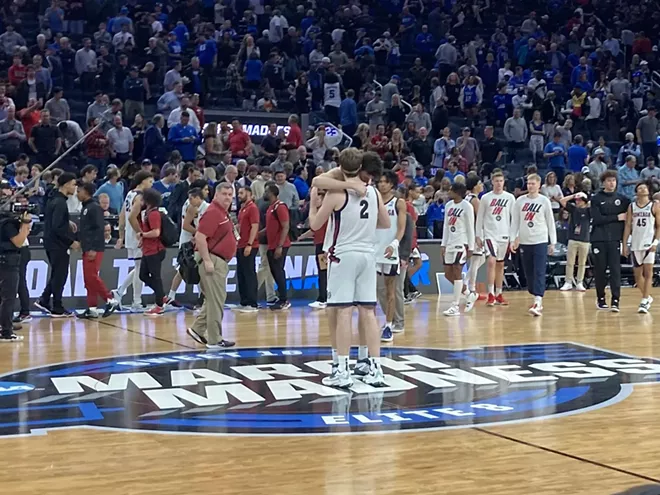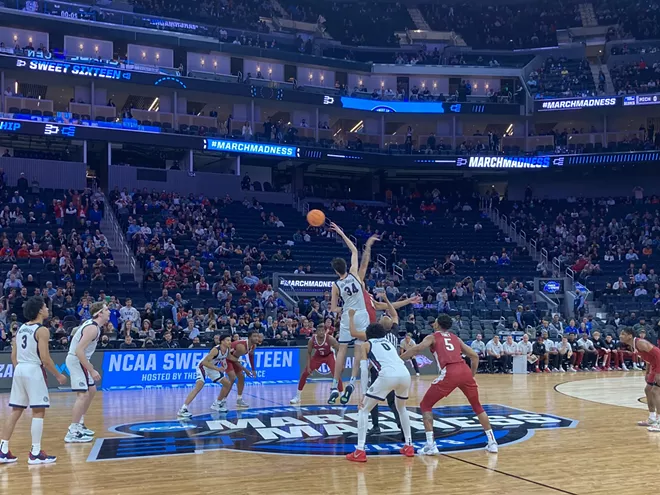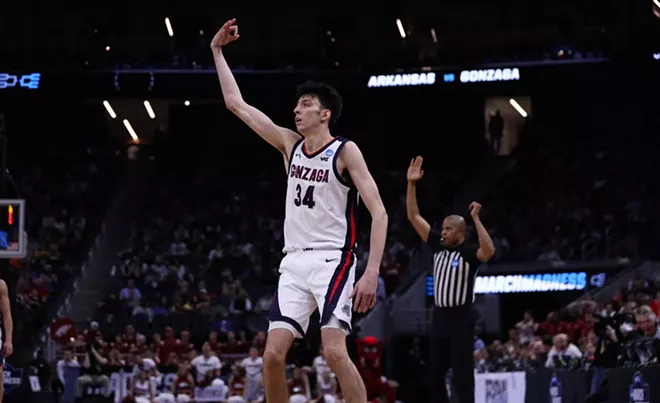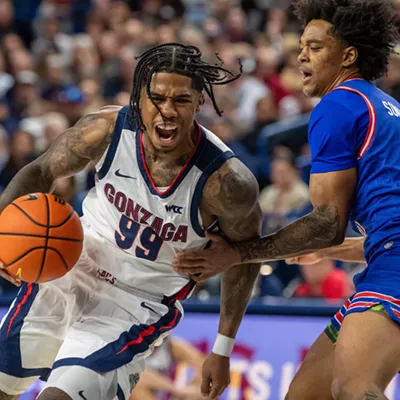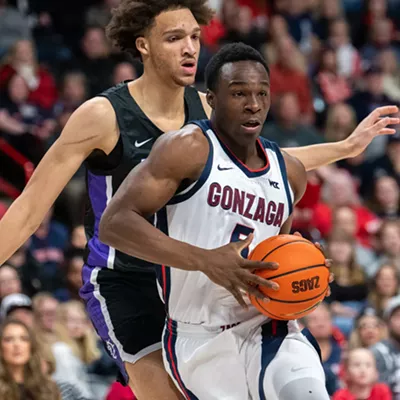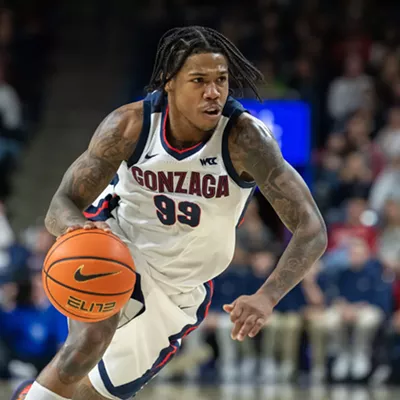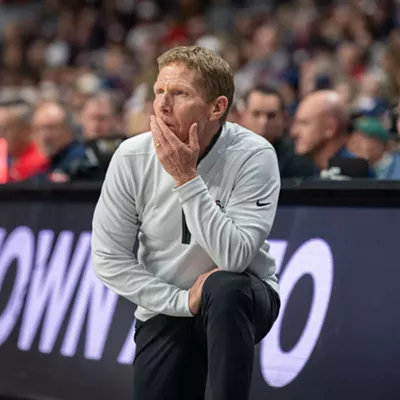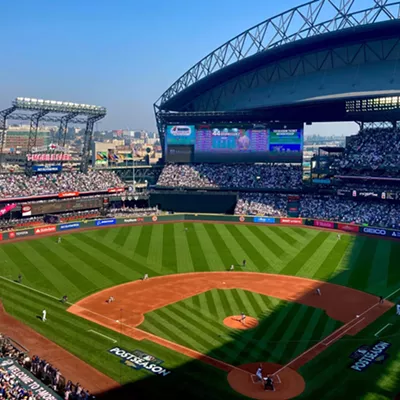That final buzzer echoing throughout Chase Center managed to do the impossible.
For a moment in its aftermath, Chet Holmgren felt small.
The gravity of the season's finality — the likely endpoint of his college basketball career — weighed down the 7-foot-tall 19-year-old. Head down with a hangdog look drooping across his face, he strode to center court and buried his head in Drew Timme's much-shorter shoulder. At that moment, Holmgren wasn't a once-in-a-generation unicorn player, a near-lock Top-3 pick in this summer's NBA Draft and a guaranteed multimillionaire. He was just a sad college kid grappling with a crushing loss and realizing he no longer gets to play the game with all his Bulldog buddies.
But there is no reason for Holmgren to feel like he let his team or Gonzaga fans down. He might be the most unique player we'll ever get to watch suit up for the Zags, and getting the chance to watch him ply his trade on a twice-weekly basis was an absolute treat that all us Spokanites should be grateful we got to experience.
Yes, the loss to Arkansas in the Sweet 16 down in San Francisco was brutally bad. It must sting especially bad for Holmgren as the referees decided to remove him from the game. All year, Holmgren had been amazing at avoiding foul trouble. He only averaged 2.7 fouls per game, and before the NCAA Tournament he had only fouled out of one game all year.
And then he fouled out of his last two games in the NCAA Tournament.
Worse still, all three fouls Holmgren picked up in the second half were complete phantom calls. It was pure officiating incompetence that was in no way Holmgren's fault. (For Zags fans, it conjured up horrific memories of NCAA Tourney refs' unjust treatment of center Zach Collins in the 2017 National Championship game.) Seeing your team go down in flames is bad enough, but having to watch it unfairly glued to the bench is extra excruciating.
But if we're being honest, the bogus calls didn't cost the Zags a trip to the Elite Eight. Even if Holmgren had played every minute, he couldn't force Andrew Nembhard, Julian Strawther and Rasir Bolton to hit their wide-open shots. Once again, Gonzaga simply couldn't shoot, and that was the difference in the game (any narrative that says Arkansas' defense forced the Zags scoring woes is absurd — I was sitting in the second row — the shots were wiiiiiiiiiiide open).
The main thing that needs to be avoided is boiling down Holmgren's whole season to that one game. Doing so would be dismissing one of the most unique bursts of basketball we've witnessed.
There are plenty of obvious ways that Holmgren was an absolute joy to watch. He was like a graceful toothpick on the floor with his tall and gangly frame belying the fluidity of his movements. His shot-blocking was beyond elite, with his ability to block shots while maintaining possession (a la Bill Russell) having announcers salivating all season. But that doesn't even account for how many shots he misdirected or opposing players who didn't even consider going near to post because Holmgren was stationed down there. It was often comical how much worse Gonzaga's defense instantly became as soon as Holmgren was on the bench. Holmgren didn't have a bad game all year. Even when his offensive box score stats might look "bad," his defensive impact always tipped the scales in the positive.
While many skinny 7-footers are stiffs, Holmgren could grab a board and dribble it up the floor and take it to the hole seemingly in one gust of motion. His shooting touch from behind the arc was always breathtaking. He even had a sequence where literally all these skills were on display in the course of two minutes in the game at San Diego, a highlight reel that will forever be a part of Gonzaga lore.
But there were also overlooked details about Holmgren that were wowing. I don't know if I've seen a player with a better sense of his own length. Untrained viewers might've seen times when Holmgren ceded ground in the post as evidence he needed to put on more weight, but it became clear he so often intentionally let offensive players get near the rim because he knew he was still in the perfect position to swat them. I've never seen anyone bait the other team into getting their shots blocked in that way.
Another of Holmgren's biggest strengths also may have been somewhat detrimental — he's too much of a team player. Holmgren always seemed totally content deferring to his teammates on the offensive end of the floor, despite possessing more offensive skills than them. Holmgren only averaged 8.8 shots per game, less than Nembhard (9.7) and basically even with Strawther (8.5). The fact that Mark Few's game plan didn't try to force the issue to
It's a shame (but a reality) that any Gonzaga team that earns a top ranking and doesn't end up winning the title will be viewed as a failure. But it's important to latch on to the things that make each "disappointing" season magical in their own way.
I won't ever forget watching Chet Holmgren play for Gonzaga.
It's OK to feel sad that it's over, kid. But you have nothing to hang your head about.

